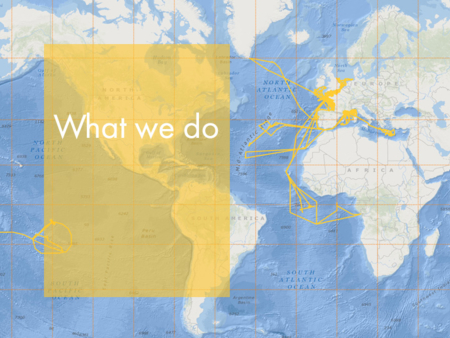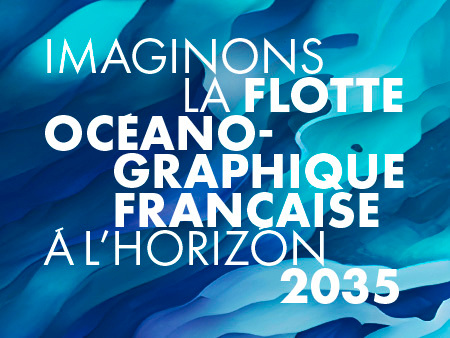Expected role of project leader on Ifremer oceanographic research vessels
Remit and duties
An oceanographic research vessel, regardless of whether it is coastal or ocean-going, is an instrumented, floating and mobile platform that, depending on the environment where it is developed, follows specific legal rules. On-board scientists’ attention should be drawn to the fact that these rules are considerably different to the rights and obligations applicable to them on land (authority, organisation on board, etc.).
Aside from specific ideas such as ownership, ship-owner or technical manager, three major players appear throughout any campaign on board Ifremer oceanographic research vessels: the vessel’s captain, the project leader and the Genavir head of operations. These three players interact throughout the mission to make it a success.
As a recap, a mission is the period that runs between mobilisation and demobilisation of a vessel. For periods before and after this, the project leader, and members of the scientific team are subject to procedures and methods from the mission orders signed by their respective employers or enabled authorities.
The project leader that works on board an Ifremer oceanographic research vessel* in configuration and organisation of contemporary research, nowadays might be either a salaried worker at Ifremer (that owns the ship), or subordinated from another French research organisation or a charterer, or be governed by a statute (public function), or even an EU citizen, possibly within the framework of the OFEG (Ocean Facilities Exchange Group), the French Navy or even from outside Europe.
* This note is limited to the Ifremer’s only scope as the agency for resources and therefore vessels which it owns and the partnership agreements signed by Ifremer. This does not refer to regulating tours on third party vessels.
This project leader is the single point of contact for the institutional operator (Ifremer) and the technical administrator (Genavir) and ensures interface with its scientific team. He follows all the rules (particularly rules from the vessel guide available on the QHSE site like all other personnel working on board the oceanographic fleet vessels). Abiding by these rules is stipulated in the campaign preparation protocol.
This research activity falls within a programme, a project** and a campaign proposal dossier validated by the National Ocean-going Fleet Commission (to assess ocean-going campaigns) or the National Coastal Fleet Commission (to assess coastal campaigns). Throughout the mission, the project leader oversees that the targeted research results are obtained. Due to the nature of his scientific or technical work, he has a campaign plan (task schedule). This is successively specified during:
- The sea campaign proposal dossier, established following the national call for bids, that will be assessed by national assessment commissions (CNFH or CNFC) (see rules of the national device for assessment and programming of oceanographic campaigns);
- Drawing up the mission preparation dossier that, after validation from Ifremer, will be sent to Genavir and will be used as a basis for the mission preparation meeting;
- validation of the report from the mission preparation meeting (CRPM) by the Ifremer programming officer, the Genavir Director of operations and logistics and the project leader;
- carrying out the mission;
- and finally, the mission report.
** In the scientific work organisation, the mission can be part of a project that is run by a project manager, without this person being present during the campaign at sea. August 2010.
The project leader’s remit and responsibilities during the three main phases (before, during and after the mission) of the research project in which Ifremer naval resources are involved, are described below.
Remember that the naval resources managed by Ifremer are national resources, likely to be required in specific or emergency conditions for public service missions (security, searching for wrecks, in particular). Except for the case of commercial chartering, industry research collaboration, the scientific community has a right of access and availability to use all these resources. If Ifremer has to cancel a mission, even planned for a long time, and if it is not capable of implementing substitution resources, it will not be financially liable. Ifremer does not have to reimburse any costs committed by scientific teams for a mission. Ifremer’s only obligation, in such a case, would be to notify the project leader as quickly as possible. Repatriation of personnel and possible equipment, without any particular arrangement to the contrary before the mission, remains the responsibility of their own organisations.
Before the mission
The project leader drafts a campaign proposal dossier*** submitted to the National Ocean-going Fleet Commission (to assess ocean-going campaigns) or the National Coastal Fleet Commission (to assess coastal campaigns). He has to accept the expertise and assessments on his project and the decision that is made by the management committee of the French Oceanographic Fleet Board (DFO) then the Ifremer CA on whether or not to programme the mission with regard, on the one hand, to the scientific and technical assessment and on the other hand, the budgetary capacity to programme this campaign, or not.
*** In certain very specific cases (National Navy-Ifremer type partnership), this prior principle is contravened
In his campaign proposal dossier, then at a later stage more refined in his campaign preparation dossier, he indicates the tasks to be carried out during the campaign in order to obtain the chosen results and, as precisely as possible, the work zones, the chosen ports if need be (the decision is Ifremer’s as a last resort, depending on the local security, safety and accessibility conditions), the stop-over time in the event of needing to rotate the scientific team. For this purpose, it provides an accurate map of the envisaged deployment in order to allow both the Naval Operations Centres of the Oceanographic Fleet Board (DFO/PON) and/or Genavir that for the State services, objective assessment of security. On the other hand, DFO/PON and its operator Genavir provide the available resources to complete the mission.
There should be a reminder here that, in its constant concern to optimise FOF vessel programming, the DFO reserves the possibility of turning down any request from the project leader that is not justified from a scientific or logistic point of view.
In his role running the on-board team, in compliance with the goals of his campaign plan, he contacts scientific and/or technical teams from different French or non-French institutes to perform these tasks. Each team must draw up a list of competent on-board members who are available for the envisaged campaign date. He notifies their team, as soon as it is set up, about how the campaign will be run, any envisaged stop-offs, and measures that might be taken to ensure the campaign’s scientific or technical success, but also the mission’s safety from information given by DFO/PON and/or Genavir.
Using his campaign preparation dossier, he informs Ifremer and Genavir about the list of personnel on board, the organisation they depend on and the employer HR contact for each one.
If necessary, within deadlines given on the French Oceanographic Fleet site, he must send DFO/PON a dossier detailing jobs in territorial waters and foreign countries’ exclusive economic zones so that requests for authorisations are made by Ifremer, solely authorised to intervene with the military and diplomatic authorities.
He must receive updated information on any changes to campaign safety from the DFO/PON and/or Genavir depending on the envisaged work zone and, if need be, regarding any change in campaign programming. He should be notified regarding this information as quickly as possible.
He is the direct and sole point of contact with Ifremer and/or Genavir on how to prepare and run the campaign. From this stage of obligation onwards, he must inform his team about any evolution or constraint likely to interfere in the initially envisaged campaign plan. Based on the information obtained from Ifremer and/or Genavir, he should send out the warnings, updated information or arrangements made in the field of safety, depending on the zones in which the mission is taking place, in order to allow personnel to exercise their right to withdraw if they wish.
He has the responsibility to inform the scientific team about the regulations in force, and more specifically the latest evolutions that he is aware of or that he has been notified of during the different campaign preparation meetings, as well as different instructions given either by Ifremer or by Genavir concerning on- board personnel.
He makes sure that all personnel that are not sailors, accompanying him on this mission, have a medical certificate to prove they are fit to be on board (and, if need be, regarding diving) and for the work to be accomplished on board the vessel; he takes responsibility for collecting them and handing them over to Genavir. He will have reminded everyone, well before the vessel’s captain, during the mission preparation phase, that no personnel will be authorised to go on board the vessel if they do not hold this certificate. For good management, it is appropriate for medical certificates to be checked before the interested parties leave for the boarding port. When boarding, he oversees handing over his team members’ confidential medical files to the vessel’s captain. Before leaving on the campaign, he must obtain the following information concerning each member of his scientific teams: emergency family contact and contact details for the employer HR manager for each person. He is given this warning role during the preparation meeting.
He informs Ifremer and Genavir about the scientific and/or audiovisual equipment that his teams wish to bring on board.
During the mission
The mission in the strictest sense should be defined as the period that goes from the start to the end of availability; in the broadest sense, the mission will be framed by the journey to join up with the vessel and the return journey back to their usual workplace, as part of a mission order.
The project leader is the single point of contact for the captain to organise the scientific team’s work. He forecasts a daily operations schedule to the captain and to the machine operations chief in order to plan the tasks and make sure that equipment is operationally available. The captain decides whether or not to carry out a specific operation.
He runs and manages the scientific or technical team; in this capacity and regarding it, he plays an organisational role during the campaign and also runs and scientifically coordinates all the tasks planned within the mission.
If any changes must be made to the initial programme, the project leader and also DFO/PON will be informed of this situation by the captain (and/or Genavir/DoI) as quickly as possible in order to pass judgement, particularly concerning the consequences of a modification to the campaign plan.
The decision regarding tasks at sea falls, as a last resort, to the vessel captain depending on the constraints (technical, weather-related, etc.) and the instructions (on security or safety during the mission) that the shipping line might have given him beforehand or, if circumstances require it, in real time. As the sole point of contact, the project leader is kept informed as soon as possible.
Although, in practice, the project leader might speak directly to crew members, more specifically to the first officer, the deck watch officer or the bosun to obtain a service, they do not have to reply without the captain’s agreement.
At the start of the mission, he and the first officer run through the list of chemical products and places where they are used. He appoints a chemical supervisor on board and puts someone in charge of each laboratory who will inform him and the first officer when specific hazardous products are used and handled (hazardous for on-board personnel or for the environment).
He must inform the captain about any incident or accident that he is aware of, that occurred during scientific work or in the vessel’s laboratories. If anyone is involved in an accident, with the captain’s agreement, he notifies the HR department at this person’s organisation within 24 hours.
Before the end of the job, he makes sure that the scientific team leaves the premises (laboratories, computer rooms, living quarters) in good condition, just as they initially found them.
After the mission
After the campaign, he sends end of campaign documents to the DFO and to Genavir, including the end of campaign assessment sheet in compliance with the procedure in force. He will be particularly careful to provide DFO/PON and Genavir with a precise report on any incidents and accidents that he was aware of during the campaign.
If the campaign took place in foreign waters (territorial waters and EEZ), he will provide DFO/PON with a preliminary report for the mission (Preliminary Cruise Report = PCR), to be sent on to the appropriate country as quickly as possible.
He hands over the data acquired during the campaign, if need be, to the project manager and makes sure that the data is filed and made available to the people involved.
The project leader (or his project manager) takes part or provides the necessary documents for all communication or assessment operations on the campaign, particularly dissemination of knowledge and results to the general public, the educational field and the socio-economic world, etc. within Ifremer’s communication policy. However, as the project leader’s work is primarily scientific, he can counter a reasonable deadline, appreciated case by case, to preserve the results obtained (confidentiality, publications prior to any communication, etc.).
Within the framework of their scientific work, just like all personnel on board Ifremer naval resources, the project leader must make sure that the data acquired during the mission will be properly used (articles, conferences, patents, technical reports, theses, etc.). Every year, he provides a campaign assessment sheet and after 4 years, an assessment dossier to be evaluated by the CNFH or by the CNFC. This assessment is particularly useful to measure the scientific or technical impact of oceanographic campaigns.
He acknowledges awareness of arrangements regarding rights and obligations in terms of archiving and dissemination of data acquired on board the Ifremer vessels and to accept its content. For this purpose, he acknowledges that he is not the owner of the different types of data (audiovisual, mapping, seismic, etc.) acquired with and thanks to the naval resources, all types of machines and other technical equipment and brought together in a computer, digital or any other type of file. He commits to indicating in all publications, regardless of the support, in all manifestations, lessons or symposiums, that the data being disseminated comes from the “X” campaign carried out on the “Y” vessel from the French Oceanographic Fleet or obtained by such and such an underwater machine, copyright to Ifremer.
Unless specifically agreed with Ifremer, he promises not to exploit the images and/or data obtained for commercial purposes; on the other hand, Ifremer should ask him formally for his authorisation, if it wishes to popularise or exploit for its own needs the images and/or data acquired during the campaign that it ran.
Prior to the start of the mission and following the mission, he commits to notifying Ifremer if he and/or the on-board teams have signed or wish to sign a partnership with an industrialist, particularly joint funding of a thesis, post doc work with a view to studying the data acquired during the campaign. Before any use of the data, Ifremer reserves the right to sign a specific agreement for use of the data, for a fee or without any financial return, with the industrialist.




